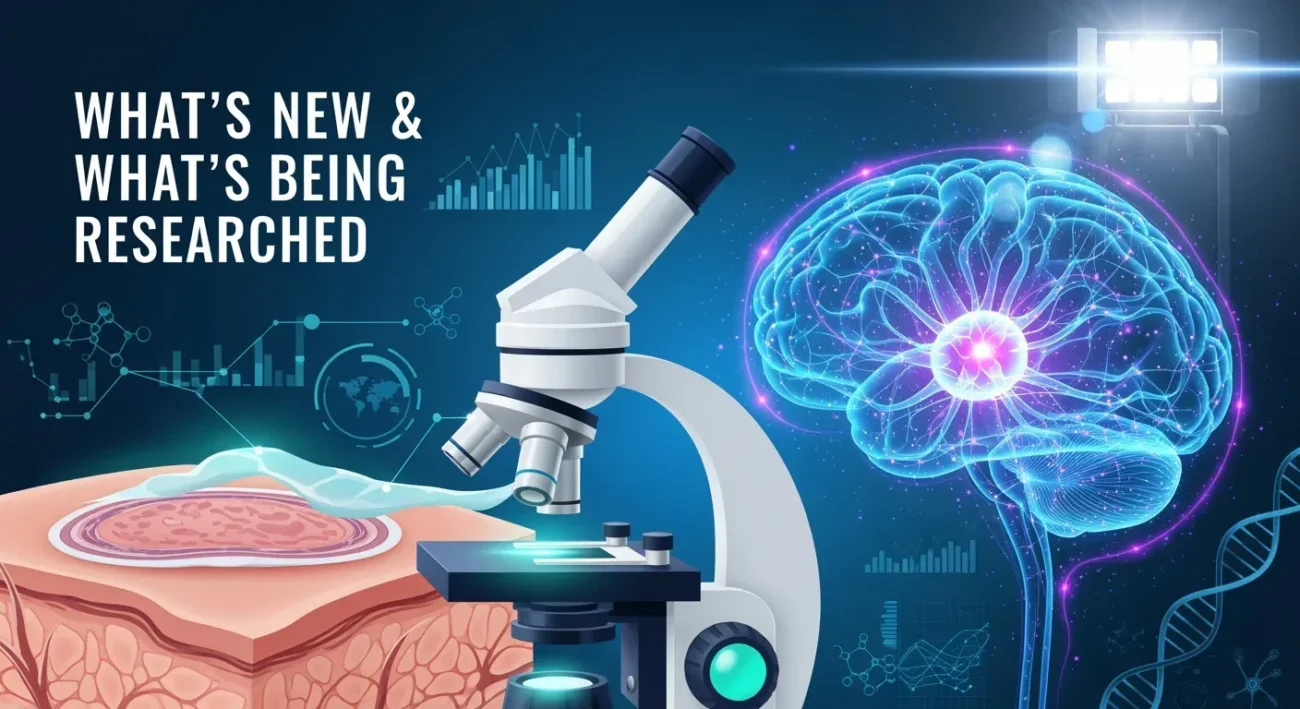Imagine waking up one morning and seeing someone in your room who isn’t there. Later that same day, you’re sharp as ever, reading the newspaper, remembering conversations. Then suddenly you trip over your own feet because your legs feel stiff. Add in vivid dreams that you actually act out in sleep. If that sounds confusing, you’re not alone and those are exactly some of the strange, shifting signs of Lewy Body Dementia (LBD).
Why LBD is hard to spot; what symptoms are common (and overlooked); how doctors make a diagnosis; what treatment options exist now; what’s being researched; and what you or a loved one can do daily to cope. By the end, you’ll be better equipped to recognize LBD early, ask the right questions, and understand what help is out there.
What Is Lewy Body Dementia?
Lewy Body Dementia (LBD) is a brain disease that causes problems with thinking, movement, sleep, and behavior.
- Dementia with Lewy Bodies (DLB): thinking or memory symptoms start early, or around the same time as movement symptoms.
- Parkinson’s Disease Dementia (PDD): movement symptoms come first; dementia symptoms follow later.
In both, abnormal protein deposits (called Lewy bodies, mainly made of alpha-synuclein) build up in the brain, disrupting how brain cells communicate.
Lewy Body Dementia Symptoms
Below are the main symptoms. Not everyone has all of them and the timing can vary a lot. But knowing these helps spot LBD earlier.
Fluctuating Thinking and Alertness
People with LBD often have times when they are alert, clear, and able to think well, then other times when they are confused, drowsy, or disoriented. These changes can happen over hours, sometimes even within the same day. The fluctuations are more prominent than in Alzheimer’s.
Visual Hallucinations
Seeing things (people, animals, shapes) that aren’t there is common. These visions tend to be detailed, vivid, and persistent. Early in LBD, hallucinations might be calm, even comforting. Over time, they can become more distressing.
Movement Problems
Similar to Parkinson’s disease: tremors (shaking), muscle stiffness, slowness of movement, shuffling walk, balance issues and falls. These symptoms may appear before, at the same time, or after the thinking problems.
Sleep Disturbances
One big red flag: REM Sleep Behavior Disorder (RBD). During REM sleep, most people’s bodies go into a kind of paralysis. In RBD, that paralysis doesn’t work well, and people act out their dreams sometimes violently. Also, frequent waking at night, vivid or disturbing dreams, excessive daytime sleepiness.
Autonomic and Other Symptoms
These include issues like:
- Problems regulating blood pressure (dizziness when standing)
- Constipation, urinary urgency or incontinence
- Changes in body temperature control (feeling too hot or cold)
- Reduced facial expressions, soft voice, small handwriting
These don’t always get as much attention but can be important signs.
Mood, Behavior & Psychiatric Symptoms
Depression, anxiety, apathy (lack of interest), sometimes delusions (false beliefs), sometimes agitation. Also, wearing off of mood may be sudden. These symptoms may be misinterpreted as purely psychiatric if the movement or thinking symptoms aren’t obvious.
Table: Key Symptoms, When They Often Appear, and What They Might Be Mistaken For
| Symptom | When It Often Appears | Might Be Mistaken For… |
|---|---|---|
| Visual hallucinations | Early or middle stage | Psychiatric illness, side effects of medications, Charles Bonnet syndrome |
| REM Sleep Behavior Disorder (acting out dreams) | Often years before dementia becomes obvious | Sleep disorders or nightmares unrelated to dementia |
| Fluctuating alertness & thinking | Early stages; days with “good” and “bad” cognition | Delirium (from infection/meds), Alzheimer’s disease |
| Movement problems (tremor, stiffness) | May come after thinking symptoms (DLB) or before (PDD) | Parkinson’s disease, side effects of medicines |
| Mood changes, depression, anxiety | Early or middle stages | Depression or anxiety disorders, reactions to stress |
| Autonomic issues (blood pressure, bladder, temperature) | Middle stages often | Other medical conditions (heart disease, diabetes, etc.) |
How Doctors Diagnose Lewy Body Dementia
Diagnosis is tricky, and it usually involves putting together a lot of pieces. Here’s how it works.
Detailed Medical History & Symptom Diary
The doctor (often a neurologist, geriatrician, or psychiatrist who knows about dementia) will ask: when symptoms began; what changed first; whether thinking and movement problems started together or one first; details about hallucinations; sleep issues; daily routines. If possible, keeping a diary of symptoms (when you’re worse, when you’re better) helps a lot.
Neurocognitive and Physical Examination
Tests to check memory, thinking, attention; also physical tests of movement, balance, reflexes. Checking whether medications you’re using could be causing symptoms.
Brain Imaging
CT scans or MRI to rule out other causes (stroke, tumors, fluid buildup). Sometimes more specialized imaging is used (PET, SPECT) to see how different areas of the brain are functioning (for example, how the brain takes up dopamine or glucose).
Sleep Study
If REM Sleep Behavior Disorder is suspected, the patient may be observed during sleep (polysomnography) to confirm that muscle paralysis is absent when it should be present, or other sleep disturbances.
Biomarkers & Emerging Tests
This is newer and where recent research has pushed forward. Two promising directions:
- Skin tests: looking for alpha-synuclein (protein that makes Lewy bodies) in health skin nerve fibers. Studies suggest skin tests may detect LBD reliably in some cases.
- Cerebrospinal fluid (CSF) tests: via spinal tap, looking for alpha-synuclein or other protein markers. Not yet in standard use everywhere.
Diagnostic Criteria
Doctors often use consensus criteria set by expert groups (for example, the DLB Consortium) which define what combinations of core and supportive features count toward a diagnosis. Features like fluctuating cognition, well-formed visual hallucinations, REM sleep behavior disorder, parkinsonism, etc. The criteria help distinguish LBD from Alzheimer’s and Parkinson’s.
Treatment and Management: What Helps Now
There is currently no cure that stops Lewy Body Dementia, but many treatments help reduce symptoms, improve quality of life, and possibly slow decline. Also essential are lifestyle changes and support. Treatment must be personalized.
Medicines for Thinking, Memory, and Hallucinations
- Cholinesterase inhibitors (e.g. donepezil, rivastigmine, galantamine): often first choice to help improve memory, alertness, thinking. Studies suggest they may slow cognitive decline over years and reduce mortality in the first year after diagnosis.
- Memantine: sometimes used later to support memory and thinking; added when symptoms are more advanced.
- Parkinsonism medications (e.g. levodopa): to improve movement problems. But they carry risk: may increase confusion, hallucinations, or delusions if not used carefully.
Medicines for Sleep, Mood, and Behavior
- Treatment for REM Sleep Behavior Disorder: sometimes melatonin or sometimes clonazepam. These help reduce dream-acting.
- Antidepressants (SSRIs, SNRIs) for anxiety, depression. Must monitor interactions and side-effects.
- Hallucinations and psychosis: there’s a big caution here. Some antipsychotics (especially “typical” ones) are dangerous in LBD. Alternatives like low-dose atypical antipsychotics, or in some cases newer agents like pimavanserin, may be used carefully.
Non Medication Strategies
These are often under-emphasized but very important.
- Create a stable, calm environment: consistent routines, minimizing clutter and noise, good lighting (especially to reduce hallucinations shadows), easy-to-use furniture.
- Physical therapy, occupational therapy: to help mobility, balance, strength. Helps reduce falls.
- Speech therapy: if speech becomes soft or swallowing becomes an issue.
- Sleep hygiene: good bed-time routines, avoiding stimulating activities before bed, ensuring safety if dream acting out, padding or modifying bedroom environment.
- Cognitive stimulation: doing puzzles, engaging social activities, memory games all adapted to ability.
Monitoring & Safety
- Watch for side effects of medications, especially those that may worsen cognition or cause heart issues.
- Review all medications other doctors have prescribed: some might worsen symptoms (e.g. certain anticholinergics, sedatives).
- Prevent falls: use mobility aids, remove tripping hazards, ensure good lighting, support when moving from sitting to standing.
What’s New & What’s Being Researched

This section gives you the cutting edge what might change in future.
Skin Biomarkers
As mentioned, researchers are developing skin biopsies to detect alpha-synuclein. One study showed skin tests were negative about 97% of the time in people who didn’t have diseases linked to alpha-synuclein, suggesting good specificity.
Slowing Cognitive Decline
Recent research (e.g. from Sweden’s Karolinska Institute) found that using cholinesterase inhibitors early may slow cognitive decline over 5 years and reduce first-year mortality.
Disease Modifying Agents (DMA) Under Trial
- Several new drugs are being tested that aim not just to ease symptoms but slow or stop the disease process.
- Some trials are looking at reducing buildup of alpha-synuclein; others focused on brain energy use (mitochondrial, metabolic studies) since brain energy decline seems to happen early in life of disease.
Better Diagnostic Tools & Early Detection
- Advanced imaging (PET, SPECT) to detect dopamine transporter loss or other metabolic changes earlier.
- Sleep studies and detailed symptom diaries become increasingly recognized as very important for early detection.
- Machine learning or AI tools (balance sensors, gait analysis etc.) are being researched to differentiate early LBD from Alzheimer’s or other mild cognitive impairment.
Prognosis: What to Expect Over Time
LBD is a progressive disease. “Progressive” means it tends to worsen over months and years, but the speed and pattern differ a lot between people.
- On average, people live 5–8 years after diagnosis, though some live more and some less.
- Early on, memory and thinking problems may be mild, and daily life still fairly normal. Hallucinations might show up early. Movement problems might start subtly.
- As disease progresses: movement problems become more pronounced; falls likely; thinking becomes more impaired; daily living gets harder.
- Late stages: dependency increases; complications (like infections, inability to swallow, severe mobility loss) often influence life expectancy.
FAQs
Q: Is Lewy Body Dementia hereditary?
A: Usually it is not inherited. But in rare cases, certain gene mutations (for example in alpha-synuclein genes) may run in families. Having a family history doesn’t guarantee you’ll get it.
Q: How is LBD different from Alzheimer’s disease?
A: Key differences include fluctuating thinking/alertness, visual hallucinations, and movement problems more like Parkinson’s. Alzheimer’s tends to have more steady decline in memory first, fewer hallucinations early, and fewer movement features initially.
Q: Can treatment make a big difference?
A: Yes. While current treatments don’t cure LBD, they can reduce symptoms, improve quality of life, possibly slow how fast something gets worse (especially when started early). Non-drug strategies also help a lot.
Q: Are there medicines to avoid?
A: Yes. Some antipsychotics (especially older ones) and certain sedatives or anticholinergic drugs can worsen confusion, hallucinations or movement issues in LBD. Always check with a doctor.
Q: When should someone get evaluated?
A: If you notice any two or more of these: fluctuating cognition/alertness, visual hallucinations, REM sleep behavior disorder, movement symptoms (tremor/stiffness), or autonomic issues (blood pressure, bladder, etc.), it’s worth seeing a neurologist or specialist. The sooner the better for getting help and planning ahead.
Conclusion
Lewy Body Dementia is complex and often misunderstood. But by knowing the symptoms to watch for, getting a careful, early diagnosis, using the right treatments, and making helpful changes in daily life, people with LBD and their loved ones can improve quality of life significantly. Research is moving forward skin biomarkers, better imaging, disease-modifying drugs that gives real hope for better tools and therapies in coming years. If you suspect LBD in yourself or someone you care about, don’t wait. Talk to a specialist, ask about the symptoms above, and begin making small changes. The earlier help begins, the more difference it can make.

